Native Son – June, 2011
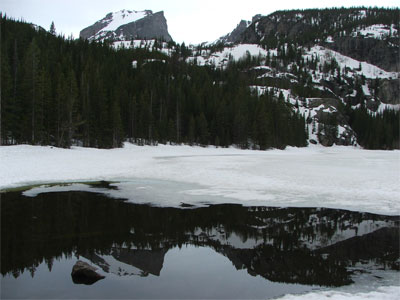
Bear Lake, elevation 9,450 ft., in Rocky Mountain National Park was a part of the writer’s early summer getaway. All photos by Steven Chamblee.
Road Trip to Colorado
There’s nothing that brings out the difference between dogs and cats like a sweltering Texas summer. Dogs have a respect for all that work the A/C unit is doing, and the cost associated with doing it. When I crack the door open to see if they want to come into the cool, both dogs immediately and simultaneously squeeze through a crack half the width of a pencil and do circles of the happy dance around the living room for a full 15 minutes. The cat, however, slowly strolls across the porch to within an inch of the door, then goes into this hypnotic, super slow motion, “what is this large, hinged portal … and is it safe to enter the abode beyond?” trance that makes Tim Conway look like Jesse Owens on a hot track. Mind you, this is the same cat that can hurl himself across the entire house in three tenths of a nanosecond … the exact amount of time it takes for that broken seal on the Tender Frisky can to make that tinny little burping sound. Enough of all this craziness … I’m hittin’ the road for Colorado!
God Bless America, there’s just nothing like the first hundred miles of a road trip vacation. Nine miles from the house, the sandwiches are coming out of the cooler. Five miles later, it’s time to refill the soda pop. Every song on the radio makes you feel 16 years old again, and the engine purrs like a three-day-old kitten. The sun is shining, the wildflowers are dancing, and the road construction crews have all decided to take the day off. We pull off over in Wichita Falls for a potty break and make our first mistake … opening the truck door. The thermometer says 108 F, but that can’t be right because the heat just burnt all the hair off my arms. I look across the gasso parking lot and see a dog chasing a rabbit … and they are both walking. My tennis shoes sound like bacon frying on the concrete. The gas pump has grown sideburns and is singing, “Don’t Be Cruel.” I get back in the truck, silently acknowledge the greatness of Willis Haviland Carrier (inventor of modern air conditioning -1902), crank the A/C up to max, and head out. I make a quick cell call to my buddy, Paul Dowlearn, head honcho at Wichita Valley Nursery (native Texas plant specialists – www.wvlandscape.com), to see how he’s doing. Bottom line: Paul is parched, but his garden still looks pretty good.
With every westward mile, evidence of the drought grows stronger. The grasslands have turned brown; the stock tanks are dwindling or dry. I once heard native plant legend Benny Simpson recount a story from West Texas in the 1950s — A man walked into a Panhandle café, threw a $100 bill on the table, and loudly wagered, “A hunnerd dollars says it never rains again!” No one took him up on the bet. — I wonder if the folks out here are starting to feel the same way. I put on my BNL Rock Spectacle cassette to lighten the mood. It works, the miles fly by, and soon Amarillo is in the rear view mirror.
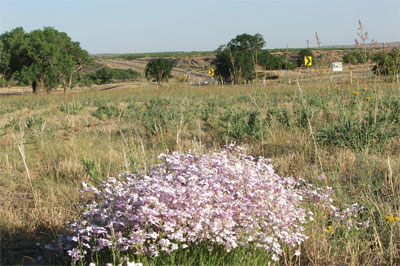
Pink plains penstemon (Penstemon ambiguous) creates a fountain of color along a parched roadside.
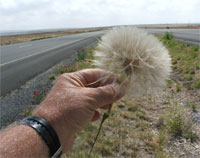
Steven holds a goatsbeard (Tragopogon dubious) “infrutescence” along Hwy 87 in the Texas Panhandle.
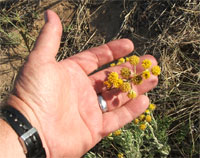
Fine-leaf woolly-white (Hymenopappus filifolius) has highly fragrant blossoms waiting to be savored.
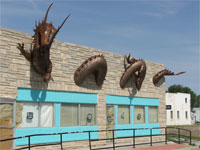
An undulating dragon swims in and out of a building in Clayton, New Mexico.
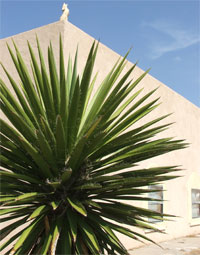
A spectacular faxon yucca in Clayton, New Mexico.
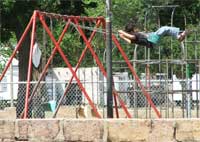
Imagination takes flight on a playground in Clayton, New Mexico.
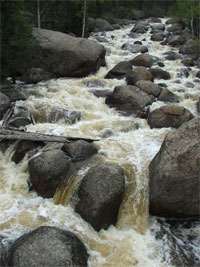
A river, swollen with snowmelt, churns down its course in Rocky Mountain National Park.
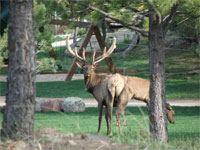
Elk feed at a residence outside Estes Park. Notice the “elk-proof” fencing in the background.
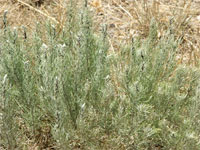
Friendly ants cluster around the stem tips of big sagebrush (Artemisia tridentata).
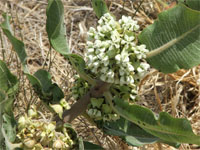
Nectar-rich blossoms and fuzzy leaves attract ants to this sand milkweed (Aesclepias arenaria).
Had my first “wildflower emergency” stop on the uphill grade half a mile north of the Canadian River (which was little more than a mud puddle). Right there in the median is a big pile of the prettiest pink flowers you’ve ever seen. It blew my mind. How could there be this luxurious colony of sumptuous blossoms out here in the middle of a parched prairie? I think I have found a new standard for the term “Texas Tough.” At first, I thought these were some kind of phlox, because of their low, dense-flowering growth habit … but the flowers weren’t right. The 2/3 pattern on the petals reminded me of cenizo blossoms … wonder if it’s in the same family (Scrophulariaceae)? A quick check in Geyeta’s Wildflowers of Texas brings me to pink plains penstemon (Penstemon ambiguus). Yep, that’s it all right. This pretty baby has semi-woody stems and is quite different from the other penstemons I know, which have rosettes of leaves at ground level with the flowers high above on sturdy stems.
While I’m out there stomping around, I find a number of interesting wildflowers in bloom, including a primrose, a butterfly weed, and that “giant dandelion” plant, goatsbeard (Tragopogon dubious). Also called western salsify, goatsbeard is a non-native wildflower that has spread widely across the plains, and is indeed related to the edible herb salsify. The yellow flower opens and closes rather quickly here in Texas, so most folks only notice the big puffball infructescence (a group of flowers in the fruiting stage) that lasts for days, or until the wind blows it apart. There is also a High Plains version of one of my favorites, woolly-white. I wonder if this one, fine-leaf woolly-white (Hymenopappus filifolius), could possibly smell as sweet, as wonderful, as outright intoxicating as the ones native farther east. One small whiff and I’m doing a little happy dance of my own in the middle of the median. And yes, I got one “knock it off, bozo” honk from a passing trucker. I duck back into my truck before someone decides the sheriff needs to know about this.
Spent the night just across the New Mexico border in Clayton. Interesting little town, so I take a few minutes to drive around before heading out. There is a wonderful garden at St. Francis Catholic Church, a great steel dragon sculpture emerging from a building, and the Eklund, an old (1898) hotel that has been given new life by the people around here. A killer specimen of faxon yucca (Yucca faxoniana) rises majestically skyward near the church, pointing to the coyote finial atop an adjacent building. But my favorite sight is over at the school yard. A small boy is on the swings by himself, swinging high and hard and fearless amid steel pipes and dust. I think back to the days of my childhood, when I could easily turn a swing into a spaceship and rocket up into the clouds. I can still feel the weightlessness at the top of the arc, when I would fly right up off the seat and only my grip on the chains separated me from a terrible crash landing. I silently cheer him on as I drive away, and hope that 40 years from now, he might also remember his time on the swings as magic.
High Country Colorado in the summer is like … well, High Country Colorado in the summer. Firs and pines and spruces and streams and brooks and rivers and magpies and hawks and hummingbirds and mule deer and elk and elk and elk…. I get all excited and take 30 photos of the first elk I see, some 200 yards from the truck. A week later, I’m not even photographing the herd as they cross the road in front of me. It is wonderful to witness nature’s bounty, even if no one up here in the mountains really gardens much because of all the munchers around … or maybe because Mother Nature is doing a fine job all by herself that people would just kind of mess it up. The weather is miserable, with highs in the 70s and lows in the 40s. Snow flurries one night. Several folks thank me for bringing the sunshine, as they are tired of all the rain. I cringe inside at the thought of how much just a spoonful of that rain and a little puff of that cool air would mean to the folks a few hundred miles south of here. C’est la vie; telle est notre monde.
The drive home is long and tedious, punctuated by only a few stops. (I knew I should have taken two more days off work.) A silvery cloud of foliage brings me to a stop, and as I am out there harvesting some of the fragrant sagebrush (Artemisia tridentata) for smudge sticks and chimnea starters, I find my hands covered in ants. I dust them off and gladly realize that I have not been bitten. Hmmm, glad these are nice ants … most ant species play nice, but the mean ones have brought wholesale ant fear to our society. Interestingly enough, it is only the young sagebrushes that bear the ants … LOTS of ants. The taller, older plants are clean. Hmmm, that’s odd. So I’ll limit my harvest to the taller ones … easier to reach, anyway. I notice a sand milkweed nearby. From what I can tell, sand milkweed (Aesclepias arenaria) is the shortest, stoutest, thickest-leaved milkweed in Texas. Its growth habit, cream-colored flowers, and the axillary inflorescences (the flower clusters emerge where the leaves attach to the stem) make it easy to identify. Did I mention ants? This baby is boiling with them. I assume they are doing double duty here on this plant, both gathering nectar/pollen and “farming” the little aphids that always seem to colonize on milkweeds. Who knows for sure? They might just be using the leaves for shade … which is a great idea, ‘cause it’s HOT out here! Welcome back to Texas, Stevie!
About the author: Steven Chamblee is the chief horticulturist for Chandor Gardens in Weatherford and a regular contributor to Neil Sperry’s GARDENS magazine and e-gardens newsletter. Steven adds these notes:
This article is dedicated to Wilma Chandler of Rockwall, Texas, who reminded me just how wonderful, how powerful, a few kind words can be.
Make sure your summer’s not a bummer. Head out to Chandor Gardens for a stroll in the shade. Just take I-20 west to exit 409, hang a right, go 2.1 miles and hang a left on Lee Avenue. Head straight 12 blocks and you’re driving in the gates. Call 817-361-1700 for more information. You can always go to www.chandorgardens.com for a picture tour and more information.
I can always use another road trip! Let me know if you’d like me to come out and speak to your group sometime. I’m low-maintenance, flexible, and you know I like to go just about anywhere. No city too big; no town to small. Just send me an e-mail at schamblee@weatherfordtx.gov and we’ll work something out.
